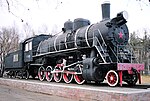Under the Whyte notation for the classification of steam locomotives, a 2-10-0 is a locomotive with two leading wheels, generally in a radially swinging leading truck, and ten coupled driving wheels, five on each side. This arrangement was often named Decapod, especially in the United States, although this name was sometimes applied to locomotives of 0-10-0 "Ten-Coupled" arrangement. These locomotives were popular in Europe, particularly in Germany, and in Russia; British use of the type was confined to the period during and after World War II. In the United States, the 2-10-0 was not as popular but was a favorite of a small number of railroads, mostly in mountainous terrain. The 2-10-0's main advantage was that five out of six of its axles were powered, meaning almost all the weight was available for traction rather than being distributed over pilot and trailing wheels. The long rigid wheelbase caused problems on tightly curved track, so blind drivers were used on the central axle and sometimes on the second and/or fourth axles. Often lateral motion devices were attached to the leading drive axle. This wheel arrangement's disadvantages included the firebox size restriction caused by the lack of trailing wheels. The type operated as freight engine, although locomotives in Germany and the United Kingdom proved capable of hauling passenger trains.
Recently selected: Timetoget - 2009 Washington Metro train collision - Cargolink
